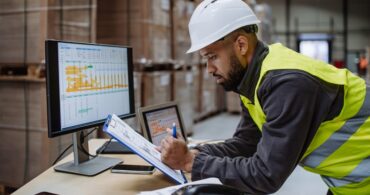The history of warehouse forklifts extends back more than 100 years. Its evolution from simple hand truck to industrial machine is a fascinating part of our evolution from an agricultural to industrial culture.
It is safe to say that today’s supply chain would not—could not—be the same without the modern forklift. The ability to quickly unload a truck, move the cargo through a warehouse, store it on a shelf 25 feet high and reverse the process for shipping is invaluable.
So, when was the forklift invented? Well, to arrive at a machine as large as a forklift, it was necessary to start small.
The first forklift ever made—mid-1800s
The forklift background begins in industrial revolution era England, which started in the mid-1700s and lasted through the mid-1800s. It was a time of massive upheaval, change and invention.
Shipping was an indispensable part of the industrial revolution, bringing much-needed materials and goods from other parts of the world to the island nation. Naturally, people needed to load and unload materials from these ships. It was hard, grueling labor, and eventually, someone created a device to make transporting sacks of goods off and onto ships easier: the sack truck.
The sack truck was manually operated. Like today’s hand truck, a sack truck had two handles at the top of a device, an extended back to rest cargo and a base to lift goods securely. Also, many sack trucks had a hand crank attached to uprights that could lift heavy items up to five feet high.
While this relatively simple machine may not be what you think of as a forklift, it had the necessary components: a pair of forked tines utilized to make lifting heavy objects easier. Hence: the first forklift.
Unfortunately, who invented the forklift, the first one anyway, is lost to time. As to when was the forklift truck invented? Well, we don’t have an exact date on that either. All we know is that during the mid-1800s, some lucky people stopped having to lug heavy sacks on their shoulders thanks to the sack truck.
Late 1800s-early 1900s
The next few decades saw a scattering of inventions that would contribute bits and pieces to the development of the forklift.
The first was a portable elevator patented in 1867. The device was stationary but could be loaded on a cart and moved around a worksite. It consisted of an upright frame, a hand-cranked hoist, and a platform. By loading cargo on the platform and turning the crank, it became much easier to lift heavy goods. Also, the device greatly resembles today’s forklift mast.
Jump forward a few decades, and we arrive at the next invention to impact the forklift (it would also revolutionize the entire world, but that’s someone else’s article): the automobile. On January 29, 1886, Karl (who also went by Carl) Benz (yes, he of Mercedes Benz) secured patent number 37435 for a “vehicle with gas engine operation.” July of that same year saw him tooling around the streets of Mannheim in his three-wheeled “Motorwagen” (that’s 13 years before Henry Ford cruised Detroit in his creation).
Skip another couple decades, and we arrive in the coal-dust-filled air of the Altoona Train Station, specifically, the luggage area where workers lug heavy, four-wheeled luggage carts to and fro. However, their job became incrementally easier when, in 1906, the Pennsylvania Railroad added a battery to help propel the vehicle. Not only did this addition save some workers’ backs, but it also came to be known as the first industrial truck.
Then in 1917, Eugene Clark at Clark Equipment Company developed the Tructractor. If you’re imagining a Bigfoot-esque monster truck, we don’t blame you. In reality, it was the first seated, counterbalanced, internal combustion-powered industrial truck. The Tructractor featured a flatbed or a cargo box that was manually loaded and unloaded, and Clark used it to haul heavy parts around his plant.
Some (like the Logistics Hall of Fame) consider the Tructractor (that name is so cool, it should be a dinosaur’s name) the first forklift. While we appreciate its counterbalanced aspect (and amazing name), the Tructractor (which was also known as the Clarktor—and yes, those two facts are the best things that will happen to you all day) was missing one key component of a forklift. It had no forks.
Affordable hydraulic systems—mid-1900s
Let’s pause our mid-20th century exploration to head back a couple of millennia to 6,000s B.C.E. Imagine you’re a Mesopotamian or Egyptian farmer. You want to grow some crops, but the stupid water is way over there while your stupid field is way over the other way. What can you do? The answer: move the water—a couple of ditches, maybe a rudimentary aqueduct or two, and voilà, the first hydraulics.
Fast-forward to 1650. A couple of smarty-pants, Blaise Pascal and Daniel Bernoulli, were hanging out thinking about water (maybe they were thirsty, we don’t know). However, what they discovered is known as Pascal’s principle (also called Pascal’s law), and it forms the basis of every hydraulic system today.
According to the Encyclopedia Britannica, Pascal’s principle “states that pressure in a liquid is transmitted equally in all directions; i.e., when water is made to fill a closed container, the application of pressure at any point will be transmitted to all sides of the container.” Imagine slapping your hand into a bowl full of water, which sends the liquid everywhere, versus slowly lowering your hand into the bowl, which just gently displaces the fluid.
Now, picture a hydraulic press with a small piston at one end, an enclosed container filled with liquid and a piston 10 times the size of the first at the other end. By pressing down on the small piston, you can lift a very heavy object placed on the larger piston. The reason is that, even though the pressure on the smaller piston may be slight, that pressure is transmitted equally throughout the liquid in the container. So, the larger piston, which is 10 times bigger than the first piston, also receives 10 times the pressure. That’s how a hydraulic fluid system works.
Most hydraulic systems require intricate planning and complex machinery, and for decades they were simply too expensive to be produced on a large scale. However, during World War II, hydraulic systems were widely used in military applications, such as aircraft control systems and heavy machinery. As the military refined its large-scale production of hydraulic systems, it led to manufacturing improvements that significantly reduced assembly costs.
Once the war ended and the global economy began its recovery, industrial production kicked into high gear, which drove demand for hydraulic systems across many industries. This spurred further innovations in hydraulic technology and manufacturing processes, making the production of hydraulic systems even more affordable.
Forklift invention—1920s
Now we’re back to our friend, Eugene Clark and his Tructractor. While hauling this and that around the factory, the vehicle often caught the attention of visitors (because it was called the Tructractor!) who often requested one for their businesses. This happened so frequently that, in 1919, Clark opened the Clark Tructractor Company.
In 1922, the company (with the amazing name) introduced the (less fantastically named) Truclift. The Truclift’s innovation was that it used hydraulics, not mechanical gears, to lift a load. Still no forks, though.
In fact, Clark would not introduce our beloved forks to what would become known as the forklift. That honor belongs to the Yale & Towne Manufacturing Company. In 1923, Yale introduced a machine that anyone today would instantly recognize as a vintage forklift. In addition to forks, the machine also featured a hydraulic mast and another, perhaps even more critical, innovation. The Yale forklift featured an electric motor and a battery pack for power storage, setting the stage for the widespread adoption of electric forklifts in various industries.
Standardization of pallets—1930s-1950s
The main benefit of forks—and the reason they eventually became industry standard—is that they significantly reduce (or eliminate) the need to manually load cargo onto a vehicle. Unfortunately, while the forklift was in its infancy, the cargo made this impossible. Not only were there multiple boxes of varying sizes, but cargo was also shipped in sacks. Sacks and forks are not a great combination, unless the goal is to have grain scattered across the floor from a torn bag. All of this cargo needed something for the forks to lift: a pallet.
One of the earliest pushes for pallet standardization occurred during World War II. Always looking for a way to streamline processes, the U.S. Department of Defense needed more efficient handling and transportation of military supplies. This led to the invention of the “four-way entry” pallet design, which allowed forklifts to lift a pallet from any side.
Following the war, economic recovery, the growth of industrialization and the expansion of international trade further emphasized the importance of pallet standardization. While there still are some variations in pallet sizes based on industry, country and regional preferences, they are all forklift compatible.
New storage needs—1950s
Warehouse needs began to change in the mid-20th century with the growth of the manufacturing, distribution and retail sectors. Warehouses had to adapt to handle larger volumes of goods.
Soon warehouse space was at a premium, and warehouse owners and operators had to make a choice. They could grow out, which meant building new structures and additions dependent on available space, or they could grow up by installing taller shelving.
The decision was a relatively easy one. As shelving rose, forklifts needed to adapt their masts with improved stability and higher lift heights. The aisle widths also became narrower to accommodate more shelving units. However, the older forklift models were too big to fit and couldn’t make the sharper turns. So, narrow aisle forklifts, such as reach trucks and order pickers, were introduced with specialized features like articulated masts, side-stance operator positions, and advanced navigation systems.
Battery improvements—now
Forklift batteries have significantly improved, driven by technological advancements and the need for more efficient and sustainable energy sources.
Modern forklift batteries have higher energy density, meaning they can store more energy within a given volume or weight. This allows for longer operating times between charges and increased productivity. Improved energy density also contributes to the overall efficiency of forklifts.
Traditional lead-acid batteries have been enhanced with maintenance-free designs, reduced water consumption and improved charge acceptance. Additionally, lithium-ion batteries have gained popularity in recent years due to their higher energy density, faster charging capabilities, longer lifespan and reduced maintenance requirements. Lithium-ion batteries also produce fewer greenhouse gas emissions compared to traditional lead-acid batteries.
Rapid charging solutions have become more prevalent, allowing forklift batteries to be charged quickly during scheduled breaks or shift changes. Fast charging technologies, such as high-frequency chargers and opportunity charging systems, reduce downtime and maximize productivity by minimizing battery charging time.
Standing on the shoulders of giants
The modern forklift is an impressive machine. However, it took over 100 years of innovation and drive to develop the individual pieces that combine to create this lifting marvel.
If you’d like to discuss the history of forklifts or the evolution of forklift batteries, Texas Motive Solutions wants to hear from you. Don’t forget that we also offer a complimentary forklift fleet performance analysis to ensure you have the correct batteries for your needs to keep your fleet running at its highest performance.
For all your forklift repair and maintenance needs, give Texas Motive Solutions a call at (888) 316-2459. Please fill out this form to learn about our services and discover everything we can do for you.



